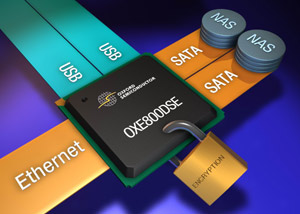Oxford Semiconductor has announced the first devices in a new family of network-attached storage (NAS) controllers, designed specifically for consumer applications. Highly integrated and supported by a complete Linux based software design suite, the OXE800 products provide OEMs with the right balance between performance and cost.
Integrating Gigabit Ethernet MAC and PCI ports, the controllers are accessible to client devices connected via Ethernet or 802.11 WiFi networks. The first two products available, the OXE800SE and OXE800DSE provide a direct interface to respectively one or two SATA drives. Both controllers feature integrated AES-based hardware encryption facilities to ensure the security of sensitive personal data.

Providing seamless interface to two SATA drives, the OXE800DSE supports RAID 0 and 1 storage configurations in primary backup roles. Storage expansion is also simple to achieve using the OXE800’s integrated USB host controllers to interface with mass storage devices.
Integrating an ARM926EJ-S processor, MMU and dual 32 Kbyte caches, the NAS controllers run the Linux operating system (V2.6) with a full network stack, ensuring development of customer specific features and applications is both simple and rapid. A web-based configuration tool supplied with the controller enables system functionality to be set up via simple html web pages, which are easily customized to match OEM corporate identities.
Highly integrated devices, the OXE800s offer a host of additional features including a network coprocessor for TCP/IP acceleration, 5-channel DMA controller, DDR SDRAM controller with selectable 8- and 16-bit interface and a static memory interface for external Flash. The controllers are provided in the 19 mm x 19 mm 272-pin PBGA package.
The rapidly emerging home storage sector is regarded as one area in particular that’s set to benefit from the introduction of Oxford’s NAS controller technology. In this application, network-attached storage holds all types of personal content (music, pictures, and videos) and makes it accessible to users throughout the home via simple navigation screens on TV as well as PC based devices.
